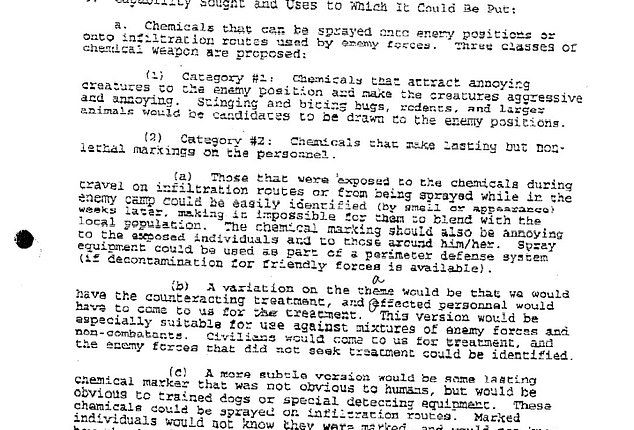The US Air Force once made plans for a ‘gay bomb’ that would use chemical aphrodisiacs to make enemy soldiers ‘irresistibly attractive to one another.’
The bizarre plan, formulated by the military’s Wright Laboratory in 1994, was part of a six-year non-lethal weapons development project costing $7.5 million that was ultimately scrapped.
A three-page document obtained by the Sunshine Project, an anti-biological weapons organization, details the laboratory’s proposal for a bomb ‘that contained a chemical that would cause enemy soldiers to become gay.’
The scientists theorized that this would make their units ‘break down’ because ‘all their soldiers became irresistibly attractive to one another.’
Even though there was no legitimate evidence to suggest this would work, the Sunshine Project found that the Pentagon submitted the proposal to highest scientific review body in the country — the National Academy of Sciences — in 2002.
The concept was crafted during a time when homophobia was generally more prevalent and accepted in the US than it is today, especially within the military.
Indeed, when President Bill Clinton tried to lift the ban on homosexuals in the military, he was met with strong opposition from top military brass.
But document itself describes the plan as ‘distasteful’ but emphasizes that it is ‘completely non-lethal.’

A three-page document obtained by the Sunshine Project, an anti-biological weapons organization, details the laboratory’s proposal for a bomb that contained ‘strong aphrodisiacs’ that would cause enemy soldiers ‘to become gay’
In addition to the aphrodisiac bomb, which the media stylized as the ‘gay bomb’ in the early 2000s, the document lays out several other outlandish ideas.
These include chemical bombs that would attract and aggravate stinging or biting bugs, rodents and other pests; or ‘mark’ soldiers with a scent so foul they could be easily identified as the enemy.
But the scientists at the Wright Laboratory didn’t stop there.
In the years that followed, they also proposed chemical weapons that would make the enemy’s skin highly sensitive to the sun, stimulated flatulence among the troops and even one that would give them ‘severe and lasting’ bad breath.
The idea behind all of these proposed weapons was to distract or debilitate the enemy without killing them to give the US an advantage, but none of them ever came to fruition.
In 2005, Captain Dan McSweeney of the Pentagon’s Joint Non-Lethal Weapons Directorate told the BBC that the Department of Defense (DoD) receives ‘hundreds’ of project proposals per year.
‘None of the systems described in that [1994] proposal have been developed,’ he said.
But the scientists behind the ‘gay bomb’ did receive the IG Nobel Prize in 2007. This parody award recognizes unusual research that ‘first makes you laugh, then makes you think.’

The scientists behind the gay bomb theorized that its gases would make their units ‘break down’ because ‘all their soldiers became irresistibly attractive to one another’ (STOCK)

The idea never came to fruition. But the scientists did receive the IG Nobel Prize in 2007, a parody award for unusual research (STOCK)
The Wright Laboratory eventually merged into the Air Force Research Laboratory (AFRL) in 1997.
Today, the ARFL is still actively working to develop non-lethal weapons.
One major focus of this work is Directed Energy weapons: an umbrella term for non-lethal weapons that use focused-energy beams to damage or disable targets.
‘Today, Directed Energy weapons are being developed by the US and its adversaries for land, sea, and air and space applications,’ The Defense Innovation Marketplace states.
For example, the DoD’s Active Denial System (ADS) uses millimeter waves (a type of electromagnetic radiation) that interact with the water and fat molecules in a person’s skin to create an uncomfortable heating sensation, according to the US Government Accountability Office (GAO).
‘During testing, the discomfort persuaded individuals to move away from the area,’ the GAO states.





